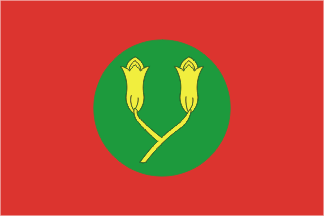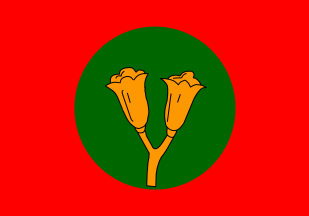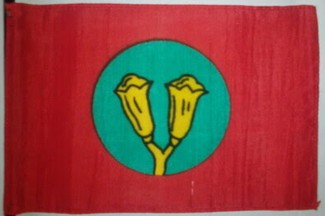![[1963 Zanzibar flag]](../images/t/tz-zan63.gif) image
by Vincent Morley, 16 Jan 1997
image
by Vincent Morley, 16 Jan 1997 
Last modified: 2025-04-26 by bruce berry
Keywords: zanzibar | clove |
Links: FOTW homepage |
search |
disclaimer and copyright |
write us |
mirrors
![[1963 Zanzibar flag]](../images/t/tz-zan63.gif) image
by Vincent Morley, 16 Jan 1997
image
by Vincent Morley, 16 Jan 1997
On 10 December 1963, the Zanzibar Protectorate was granted independence
as the Sultanate of Zanzibar by the British. The flag adopted was red with
a green disc upon which were two yellow cloves. (Possibly because the flag
was short-lived, variations exist on the design of the cloves.) The Sultanate,
and its flag, didn’t last long. On 17 January 1964 there was a violent
Marxist/Africanist coup which resulted in the deaths or expulsion of an
estimated one in five of the Arab population.
Stuart Notholt, 29 Jun 1996
The short-lived flag seems to be the only flag go ever feature cloves. Gernot Katzer's
Spice Dictionary has more details on cloves. Cloves are produced by the clove
tree Syzygium aromaticum ([L.] Merr.
& Perry), aka Eugenia caryophyllata and Caryophyllus aromaticus
(Myrtaceae family). In traditional pharmaceutical nomenclature, cloves are called Flores Caryophylli. They are indeed floral buds.
Cloves are strongly aromatic and have a very intensive fragrance, a
fiery and burning taste. The content of essential oil in cloves of good
quality may exceed 15%. The oil itself is dominated by eugenol (70 to
85%), eugenol acetate (15%) and B-caryophyllene (5 to 12%), which
together make up 99% of the oil.
The clove tree is endemic in the North Moluccas (Indonesia) and was
of old cultivation on the islands of Ternate, Tidore, Bacan and the
West coast of Halmahera. The Dutch extended cultivation to several
other islands in the Moluccas, but only after the end of the Dutch
monopoly (18th century), clove trees were introduced to other countries.
The most important production area today is the island of Pemba, which together with Zanzibar, forms one part of the state of Tanzania. The
whole island of Pemba is covered with clove gardens, and it is reported
that the island can be smelled on any ship approaching it. The short-lived
Sultanate of Zanzibar and Pemba (1963–1964) had a flag showing two
clove buds.
Cloves are also grown on other East African islands, most notably,
Madagascar. In Indonesia, clove production has recovered from poor
decades after World War II, such that the country was forced to import
cloves to satisfy the huge domestic market. Since the 1980s, Indonesia
is again producing in large scale, although little of the Indonesian
crop gets exported. Cloves are an ancient spice and, because of their exceptional aromatic strength, have always been held in high esteem by cooks in Europe,
Northern Africa the greater part of Asia. Trade between the “clove island” Ternate and China goes back at least
2500 years. In China, cloves were not only used for cooking but also
for decoration; anyone having an audience with the emperor had to
chew cloves to prevent any undesired smell. Arab traders brought cloves
to Europe in the time of the Romans; they were very expensive.
When the Europeans, in the Age of Exploration, finally found the clove
producing islands, they took enormous interest in securing a constant
spice supply. The few tourists visiting the small island of Ternate
(9 km diameter) will be surprised to find crumbling remnants of about
10 fortresses, built by Portuguese, Spanish, British and finally Dutch
soldiers in the 16th and early 17th century. During all of the 17th century,
the Dutch kept an effective monopoly in the clove trade, which guaranteed
high profits to them.
It is amazing that cloves are not (or at least, very rarely and only
for sweets) used in the cuisine of the Moluccas; actually, in whole Indonesia,
they are not an important spice. Nonetheless, Indonesians are the main
consumers of cloves and use up nearly 50% of the world's production.
But, alas!, not for cooking but for smoking: Cigarettes flavoured with
cloves (kretek) are extremely popular and nearly every (male)
Indonesian enjoys them. Their sweet, incense-like aroma pervades Indonesian
restaurants, busses, markets and offices. It is impossible to mention all cuisines where cloves are used; they
are much loved by the Chinese, play an important role in Sri Lankan cooking,
are extensively used in the Moghul cuisine of Northern India, enjoy high
popularity in the Middle East and many Arab countries and are a common
spice in Northern Africa. In all these countries, they are preferred for
meat dishes; frequently, rice is aromatized with a few cloves. In Ethiopia,
coffee is often roasted together with some cloves in the so-called “coffee
ceremony”.
Cloves have less use in Europe, where there strong flavour is not so
much appreciated. They are much used for special types of sweets or sweet
breads, but especially for stewed fruits (together with cinnamon). Plain
rice is often flavoured one or two cloves. In France, cloves often go into
long-simmered meat stews or hearty meat broths. In England, they are most
popular in pickles. Consequently, many spice mixtures contain cloves. They form an essential
part in the Chinese five spice powder, frequently appear in curry powders,
determine the character of the Moghul variant of garam masala and
are a component of the Arabic baharat. Mixtures from Africa containing
cloves are Moroccan ras el hanout, Tunisian gâlat
dagga and Ethiopian berbere. A well-known European spice mixture
depending on cloves is the French quatre épices.
Lastly, cloves have also established themselves in México.
The taste of the famous Worcestershire sauce (also spelled Worcester),
an Indo-British contribution to international cuisine, is markedly dominated
by clove aroma. The sauce is composed of several spices (besides cloves,
garlic, tamarind, paprika or chilies are most frequently found), fish extract,
soy sauce, treacle, vinegar (or lemon juice) and salt. There is no “authentic
recipe”, and therefore every vendor may sell his own creation.
Ivan Sache, 06 Jan 2005
![[National flag 1963-64]](../images/t/tz-zz63.gif) image
by Martin Grieve, 13 Jul 2002
image
by Martin Grieve, 13 Jul 2002
National Flag 1963-1964 of Zanzibar - ratio is 1:2 according to Alfred
Znamierowski's
(1999) "World Encyclopaedia of Flags" [zna99] and in "Flag Bulletin
XXIV No 5".
Martin Grieve, 13 Jul 2002
 image
by Martin Grieve, 17 Dec 200
image
by Martin Grieve, 17 Dec 200
Another variant of the "clove flag" which
was short-lived in Zanzibar. This version can be seen (in black and white) in
EMC Barraclough's "Flags of the World" (1965 edition) [bar65]. The drawing
shows a more squarish version, but I have expanded this to a 2:3 ratio.
Martin Grieve, 17 Dec 2009
 image by Eugene Ipavec, 20 Dec 2009
image by Eugene Ipavec, 20 Dec 2009
Another variant is that offered by
“edwinart” (aka eBay Store “Edwin’s Stuff”) who put up offer no. 200355655598
(end 29 Jun 2009) presenting it as “Vintage Parade Flag. Communist?” in the
absence of further information. The flag on offer was in the dimensions of
approx. 12” x 17”. Comments - “All sewn construction with yellow flower emblem
sewn on front and back. This one is attached to a pole but will be removed and
shipped without the pole. There will obviously be tack holes on the hoist end.” TWM disclaimer: “This and other flags I have were part of the
Tumbling Waters Museum of flags in Montgomery (AL) that went defunct in early 80s and sold out to
the Historical Society. These flags are the "culls" from the collection.”
Jan Mertens, 17 Dec 2009
Now this makes me wonder if
Barraclough got it right with regards to proportions. It is another
variant, as you mention, and we ought to draw this one up too. The most striking
"deviant" to this flag is surely Znamierowski's one but I have no doubt that
that he (and/or the Flag Research Centre) have an equally valid source. It would
be most interesting to know what that was.
Martin Grieve, 18 Dec 2009
 image provided by BlinxCat, 13 June 2024
image provided by BlinxCat, 13 June 2024
This is an actual Zanzibar Sultanate desk flag that was sold to me a few years
ago. I cannot find any other variants of it besides a couple other flags owned
by the same person who sold it to me. This variant is similar to Eugene Ipavec's
image above but the cloves extend to the bottom of the green disk rather than
floating in the middle.
BlinxCat, 13 June 2024